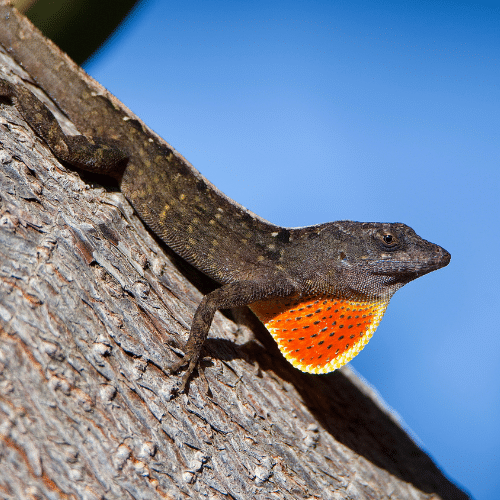
28 Sep Battling the Brown Anoles: South Florida’s Invasive Lizard
Introduction:
When it comes to Florida’s diverse wildlife, the Brown Anole, often simply referred to as the “Florida Anole,” is a fascinating and often misunderstood reptile. At Pest Busterzz, we believe in promoting harmony between humans and our natural neighbors. In this blog, we’ll shed some light on these charming creatures and share interesting facts about Brown Anoles.
Anatomy and Size:
Brown Anoles are relatively small lizards, measuring about 5-8 inches in length, with slender bodies and long tails. Their skin can change color, ranging from brown to green, depending on their mood, surroundings, and temperature.
Life Cycle:
These little reptiles have a life cycle similar to other lizards. They lay eggs in hidden, moist areas, and the young hatch as miniature versions of the adults. They continue to grow, shedding their skin to accommodate their increasing size.
Habitats Facts:
Brown Anoles are highly adaptable and can be found in a variety of habitats, including gardens, forests, and urban areas. They are often seen perched on tree trunks, fences, and walls, basking in the sun.
Reproduction and Breeding:
Breeding season for Brown Anoles typically occurs in the spring and early summer. Males engage in territorial displays to attract females, showcasing their colorful throat pouches (dewlaps). After mating, females lay small clutches of eggs in damp soil or leaf litter.
Origin and Native Status:
Brown Anoles are not native to Florida. They originally hail from Cuba and the Bahamas. They were first introduced to Florida in the late 1800s, likely as stowaways on cargo ships. Since then, they have become a common sight in the state’s landscape.
Distinctive Characteristics:
One of the most distinctive features of Brown Anoles is their ability to change color. They can turn brown to blend in with tree bark or green to mimic leaves. Their dewlaps, displayed during territorial disputes and courtship, also make them stand out.
Diet:
Brown Anoles are insectivores, primarily consuming insects like ants, small beetles, and flies. In doing so, they play a role in controlling insect populations, which can be beneficial for your garden and the ecosystem.
Property Damage:
While Brown Anoles may enter homes and buildings on occasion, they are not known to cause significant property damage. However, their presence can be unsettling to some residents.
Positive Contribution:
Despite not being native, Brown Anoles play a role in the local ecosystem by helping to control insect populations. They also serve as prey for various bird species, including native Florida birds like the Anhinga and the Eastern Screech Owl.
Conclusion:
At Pest Busterzz, we believe in maintaining a balance between nature and human spaces. While Brown Anoles may occasionally require maintenance pest control measures, they also contribute positively to Florida’s ecosystem. To learn more about our services and how we can help you maintain harmony with the local wildlife, visit our website at www.pestbusterzz.com. Together, we can coexist with the fascinating creatures that share our Florida environment.


No Comments